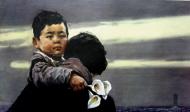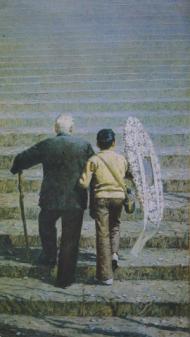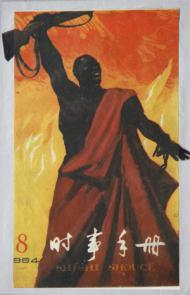Originally published in Art Observation (2000/1) and Rongbaozhai (2000/1)
Zhang Yingchuan: We know that you have been influential in the art scene since the 1950s, but we have heard little about you. Recently, many people in the art scene, including myself, have been very excited about your new painting album. We all agree that you have taken your artistic approach to a very high level. Why do we almost never see your works in important Chinese exhibitions? Why don `t we see any trace of you in major art events?
Du Yongqiao: This situation is linked to my early experiences. I lived in the countryside since I was a child, and was immersed in nature and rural life. My father, an intellectual who had been exiled to the countryside, steeped me in classical Chinese poetry, cultivating a taste for a simple, tranquil and solitary life. My love for painting is purely a natural part of my being. I have never really cared about anything outside of painting, such as exhibitions or awards. If my painting has gained any influence in the art world in the past, it is entirely due to the recognition of my long term pursuit of the language of painting, rather than such factors as exhibitions, awards or collections. My works have won awards and been collected by museums, including the National Art Museum of China, but most of those works do not represent the character of my painting. The works that truly represent my art could never attract such attention. Some of my peers have quietly enjoyed my works, and now, decades later, they clearly remember these works that were never publicly revealed. In the early 1990s, I spent four years in seclusion on a mountaintop, where I focused solely on painting and ignored the outside world. I painted nearly one hundred works during that time, and made new breakthroughs in my art. I presented some of those works at two solo exhibitions in Chongqing and Chengdu (the only two solo exhibitions I have held in China) in 1997, and found great confidence in the enthusiastic encouragement of my peers.
Zhang Yingchuan: I went to your exhibition in Chengdu and also attended the symposium. The exhibition caused quite a sensation. Though painters sincerely admire and appreciate your works, this has not changed your marginal state in the Chinese oil painting scene, a marginal state that is quite typical and representative of the Chinese painting scene. This forces us to reflect on a historical issue. Artists such as Wu Dayu and Yan Wenliang made great contributions to art, but spent a long time in the cold. The Chinese oil painting scene never gave them the appreciation or status they deserve. I think aesthetic independence has never been adequately acknowledged or emphasized in China. Do you agree?
Du Yongqiao: I agree. I think that regardless of the artist `s social background or cultural environment, he must have the ability to make clear judgments. He must not blindly parrot or believe art history that has just been written. When evaluating certain figures, such as Xu Beihong, history should give proper recognition to their contributions as art educators, but as artists, they were not pure enough. They did not contribute much in the way of the language of painting for the world to appreciate, certainly not nearly as much as the painters you just mentioned. The positions of artists in this generation are often upside down in art history. There is too much politics involved in Chinese cultural issues, and this perhaps will remain fundamentally unchanged for a long time. The problem now is even more complex. Beyond political factors, there are now commercial factors, and then there are the highly suspicious nonsense rantings of certain critics, which leave the art world in a restless, blundering state. These people are opportunistically propping each other up and bringing chaos to the art world. I think that the most rare and precious thing for an artist is to maintain judgment that is clear and independent of himself and his times, and to be completely sincere towards the art in which he engages. He must not believe or revel in any temporary glory or achievement. There are too many examples telling us that history needs a long time of tranquil contemplation to reach the correct judgment.
Zhang Yingchuan: You have just touched on some sensitive topics in the art world. Since the 1980s, many critics have actively intervened in artistic activities by stating their differing opinions. I sense that deep down, most painters resent their so called “theoretical guidance.” What do you think about it?
Du Yongqiao: There are some critics out there who are very honest, and dare to stand up to strong pressure and state their own views. They have brought vitality and fresh air to the painting scene. On the other hand, however, there are also some abnormal phenomena in the critical scene. There are people who lack basic understanding of painting but spout all manner of nonsense and engage in tactics outside of theory to build factions and elevate their own status so that they can become the theoretical guides of the painters. The louder these voices, the more chaotic this painting scene becomes, making it difficult for people to tell right from wrong, or true from false. There are some art theorists out there who do have a truly deep understanding of painting, and focus only on scholarship, while lacking the strength or resolve to stand up and criticize this state of affairs. I think that the Chinese painting scene needs insiders with true insight and a strong artistic conscience to carry out art commentary, and authoritative art publications with clear positions and high academic standards to carry out rigorous scholarly exchange.
Zhang Yingchuan: I have another sensitive question for you. How is your art connected to the postmodernist trend in Chinese painting today?
Du Yongqiao: I have never had interest in any art trends, and postmodern art certainly has nothing to do with me. I do like some works by modern or contemporary artists, and have nothing against innovators, but there is one condition, which is that it must be highly painterly. Admittedly, the rebellious and revolutionary traits in contemporary art trends have some social significance and cultural value, but if they dissolve painting language itself, then they cannot be called painting, or even art. I have always felt that the true mission of the painter is to research and make contributions in the language of painting itself. The significance of Impressionist artworks is not in that they painted ponds, meadows, dancing women or Van Gogh `s smelly shoes, but in that they marked a new breakthrough in the linguistic forms of painting. There is a widespread problem in the painting scene today, which is, just as Balthus said, that many painters say too much and do too little. They are hardly worthy of mention.
Zhang Yingchuan: Personally, as an art critic, I think that the criteria of art at the end of the 20th century is no longer about whether something is revolutionary, innovative or conservative. As long as an artist can develop his own individualized language to a level of purity and extremeness that is technically “difficult” to replace, has its own unique “perspective” of engagement, and has the ability to clash and interact in a diverse landscape, then there is value in his or her art. Many have said that your painting has reached an extreme, and that you are beyond reach on this path in the Chinese painting scene. What do you think about that?
Du Yongqiao: I have heard this quite a lot from painters, especially in the past few years. As a painter, I find praise from fellow painters much more encouraging than positive reviews from critics. For years, whether I travel north or south, I run into fellow artists I have never met who have been collecting publications of my works, and think I have strongly influenced them. I am gratified that regardless of political background or cultural environment, though I have always been on the margins of the painting scene, I have never lacked for kindred spirits across the land. I have never felt, however, that my art was perfect. I have buried myself in painting for half a lifetime, but I have never made a painting that didn `t leave me with at least a bit of regret. I feel that I still have a way to go.
Zhang Yingchuan: I see a lot of progress in your latest painting album in comparison to the one published in Taiwan in the 1980s. The freehand brushstrokes are more expressive, and the images flow more freely. Compared to Western oil paintings, your works have a strong freehand feel of Chinese painting. Do you have a clear line of thinking now?
Du Yongqiao: I did not before. When I first got involved in painting, I merely yearned to learn the languages and forms of Western types of painting, especially the unique way in which the Impressionists convey light and color. From the Russian Itinerants, I learned how to fuse the expression of light and color into exacting modeling techniques. During that long phase, I was obsessed with the research of color, and only had a few hazy views on brushwork. Later, I grew increasingly fascinated by freehand Chinese painting, and spent a long time studying the ink art of such artists as Wu Changshuo, Huang Binhong, Qi Baishi and Chen Zizhuang, which naturally led to oil painting forms marked by a distinctly Chinese approach to brushwork. I replaced the uniform brushstroke often seen in Western oil painting with more dynamic brushwork, and placed great emphasis on the rhythm and spirit of the brush. By the 1990s, I had developed this painting style to the fullest as I strove for the brushstroke to embody its own independent aesthetic taste, much like the spirit of brushwork in Chinese painting. I place great emphasis on infusing the rigid formal framework of realism with abstract elements. No matter how exacting the overall composition, when you look closely at the details, the colors and brushstrokes come together to give an abstract feel. This is Huang Binhong `s heaviest influence on me. Everything I have just said, however, has one condition, which is that I have always preserved the linguistic traits of oil painting in my work, the so called “flavor of oil painting.”
Zhang Yingchuan: There is a wave in Chinese oil painting to pursue a Chinese painting style, a nationalization of oil painting. This seems to coincide with your own views.
Du Yongqiao: I haven `t noticed such artworks, and do not know about their specific views or methods. I do not insist that oil painting must have a Chinese or national style. There is no need to be so conscious of that. In the end, art belongs to everyone. Besides, this is something people have been advocating since the 1950s, but it has always ended in failure. That is because the fusion of the Eastern and Western languages of painting is not just a simple issue of concept, nor is it something that can be realized through crude, superficial grafting. One must have a firm grasp of both, and engage in long term exploratory practice in order to blend them into a single expressive form.
Interview edited by Zhao Qing




